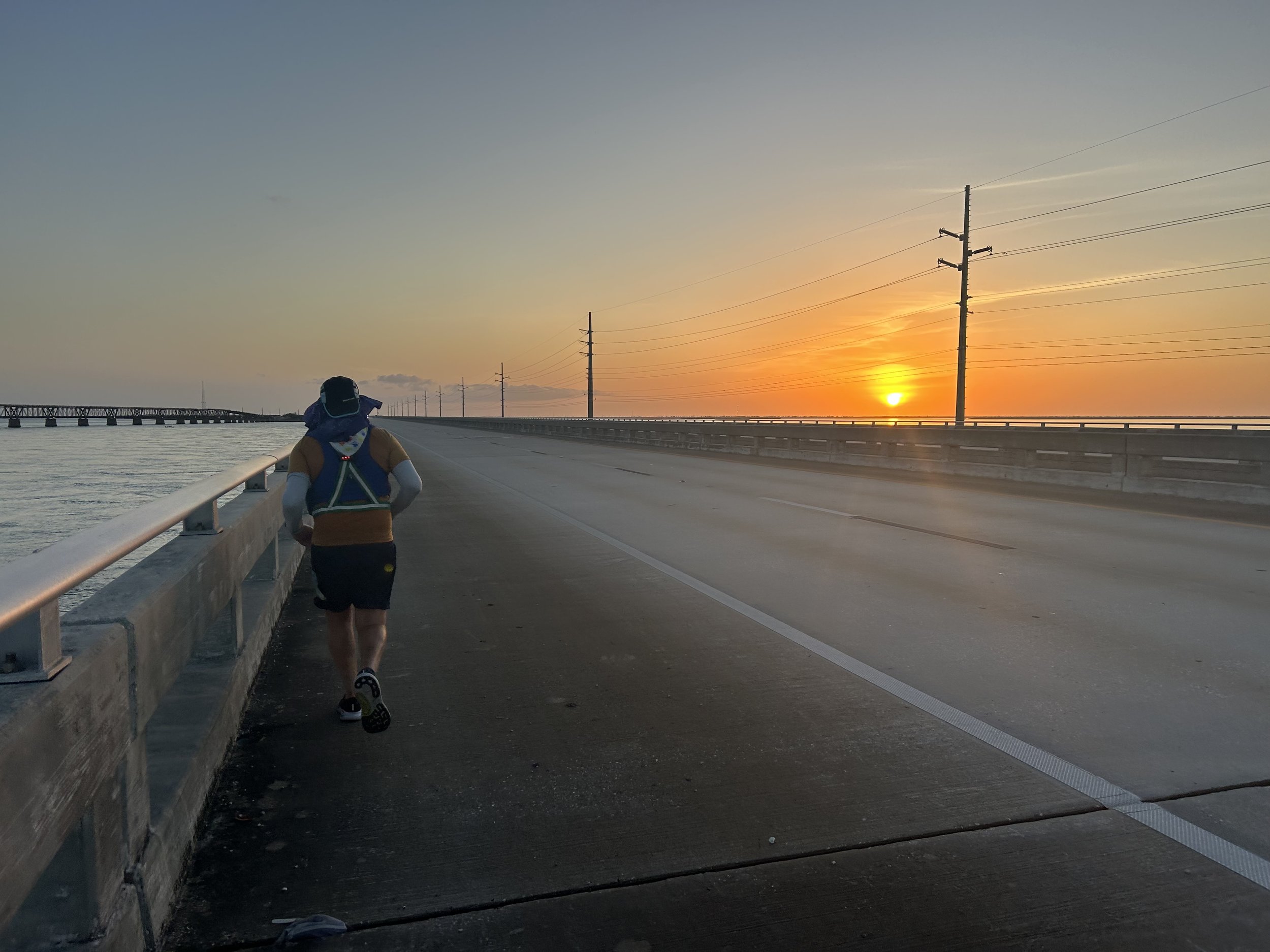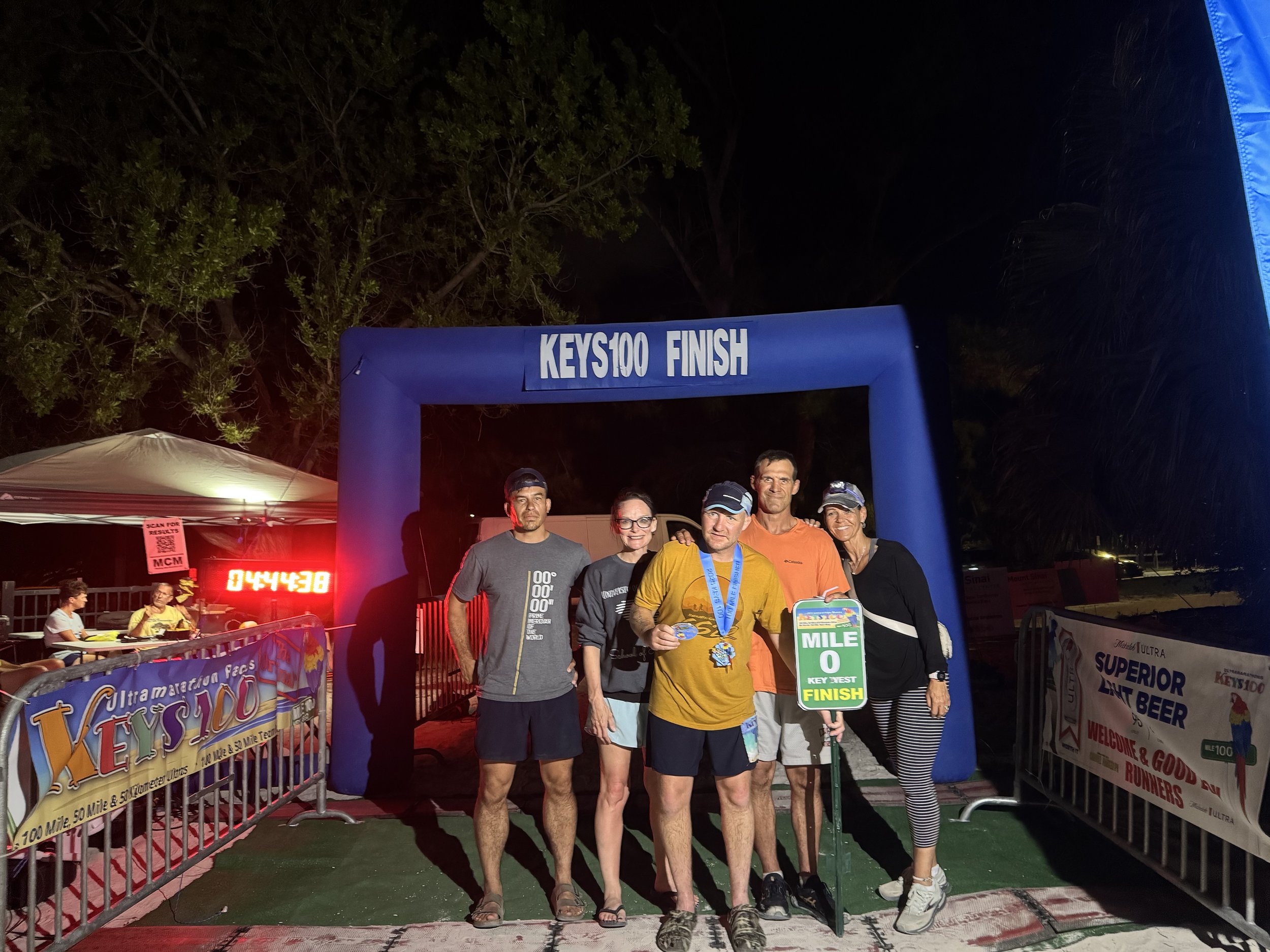Glancing down at my watch, the vibration confirmed mile 91 complete. Nine miles might seem like a technicality in a 100-mile race, but that final stretch will test your toughness, and the mental gymnastics were in full swing in my head.
My pace the previous couple hours had slowed to a walk/run combination yielding 13+ minute miles. If I kept this pace I’d be done in two hours, but it would hurt. Or I could walk it in for the final nine miles and add only 20 to 30 minutes to my time…and no one would know.
Afterall if I took the easy route, it wasn’t like I was in contention to win (in fact the winner had already showered and got a solid night rest: Brett Sanborn finished the race in 14 hours 21 minutes). I’d still finish the Keys 100 under 24 hours and receive the same congratulations from friends and family. The belt buckle on my shelf would represent doing something hard, where 60+ people DNF’d (Did Not Finish). There was no purpose to perform.
But…
What kind of teammate would I be to Stephanie, Jake, Emese, and Cody if I didn’t leave it all on the course? They traveled halfway across the United States to sit in the Florida heat, waiting hours for me to come by for minutes, refill my water, cool me off, wash my feet, and were willing to do anything to help me accomplish my goal.
What kind of Grandpa would I be if I coasted in? I thought about the cold nights in January, where I expect Dax and Brooks to listen up and work harder at wrestling practice.
What kind of reflection would I be? Could I look at myself in the mirror and say “You f’ing crushed it!”?
I knew the answers and started to run.
The Keys 100 is a hundred-mile ultra marathon that starts in Key Largo and finishes in Key West. The course is relatively easy, having less than 1000 feet of elevation gain on paved bike paths and roads. It’s virtually impossible to get lost, head south and keep going until you run out of road.
The two challenges that make this race difficult and lead to a high number of DNF’s are: Florida heat in May and the logistics of providing your own crew/aid.
Deal with the heat, and you’ll be alight. My plan consisted of starting a cooling strategy at the start line. I wore a wet bandana under my hat and an ice bandana from Rabbit around my neck. My crew replaced these at every stop. A couple hours into the race I put on sleeves that kept the sun off my arms.
Slow and steady was my mantra. It’s common to push too hard in the beginning of these races (especially on a flat course), but if you “bonk” in the heat it can be difficult to come back. When my heart rate started to “spike”, I’d slow down and kept it under control.
The Key’s 100 requires the runner to have their own support crew. They leapfrog the runner every three to five miles to provide aid at race approved meeting locations. The clock doesn’t stop, so you don’t want to get too comfortable during these breaks. Our strategy was to have three longer stops at approximately mile 25, 50, and 75. At these meetups I changed my socks, shoes, shirt, ate “real food”, and got on my way in five to six minutes. Jake, Emese, Cody and Stephanie were dialed in and performed like a pit crew for a NASCAR race. Emese replaced my water bottles, Cody worked on my feet, Stephanie replaced the ice bandanas, and Jake helped me with my shirt. At the shorter stops the goal was two to three minutes and focused on replacing the ice bandanas, replenishing fluids and replacing any nutrition I needed to consume before the next stop.
The first part of the race went smoothly. When I hit “Hells Tunnel”, which is a bike path surrounded by vegetation with no breeze the heat started to engulf me. I knew I had to remain disciplined for my pace. At mile 50 Cody joined me as a pacer. Stories and jokes boosted my morale and as we covered the next few miles the clouds covered the sun. It felt like the temperature was starting to cool off, but this was short lived as we crossed the legendary Seven Mile Bridge. The sun continued to beat down and Mother Nature reminded me who was in control. Cody and I underestimated the difficulty of this stretch and were out of water by the time we could meet our crew.
Switching pacers at mile 75 meant Jake would accompany me to the finish line. It was dark, my legs were tired, and my body was exhausted from dealing with the heat. At this point in the race, I knew I must keep moving and stick with what got me this far. I’d run for 30 seconds, walk, run for 30 seconds, then walk. Sometimes I’d go 45 seconds, sometimes 20 seconds, but I kept moving. Miles continued to melt away and I crossed the last timing station at mile 98.
Maybe it was my mind letting off a little or just 98 miles of pounding on pavement, but my back started to spasm. I had to stop a couple times to stretch to find relief, but it wasn’t much use. It was going to be a grind to the finish. Hunched over I closed the final distance until crossing the finish line on Higgs Beach…I ran out of road.
My official time was 21 hours 43 minutes and 44 seconds, good enough for a 17th place finish overall and 1st place in Male Age 40 to 44.
I was raised to always do my best, and I try to live by that principle. However, I’ve been guilty of having the mindset “this is good enough” or “this should get me by” at different points in my life. One of the reasons I run 100-mile races is I will get the opportunity to do my best. A crossroad where my body will be saying to stop or slow down, but my mind will say “you still have more to give.” Over the years I have taken both routes, but as I continue to navigate life, I know the benefits of doing my best, even if the reward is not apparent. There are a lot of circumstances I can’t control. However, I can control my performance…even when there is no purpose.






